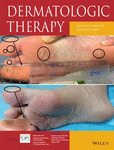Effectiveness of topical Nigella sativa for vitiligo treatment
Abstract
Vitiligo is a pigment disease characterized by the disruption of melanocyte structure and function. Its etiology is unknown; however, genetic predisposition, biochemical factors, and neural mechanisms are thought to be effective. Although many agents are being used for its treatment, generally there is no absolute cure. The aim of the present study is to evaluate the effectiveness of topical Nigella sativa seed oil on vitiligo patients. Thirty-three vitiligo patients were included in the study. Totally 47 areas were evaluated in all patients. Cream containing N sativa seed oil was topically applied to hands, face, and genital region two times a day for 6 months. Statistically significant repigmentation was detected in hands, face, and genital region, the three treatment areas, and the p values are found .005, .001, and .004, respectively. N sativa can be used as an adjuvant therapy that can contribute to the treatment especially in sensitive skin areas like genital region.
CONFLICT OF INTEREST
There is no conflict of interest to declare.




